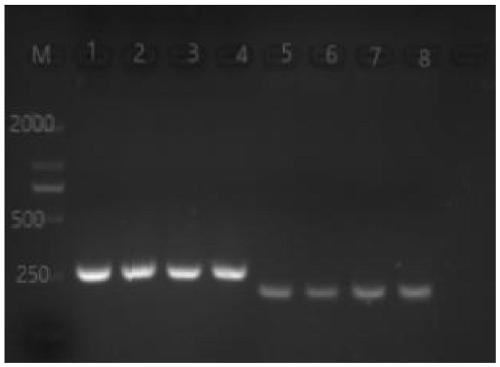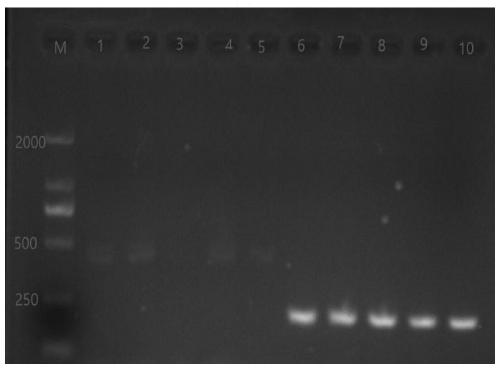Primer group, kit and method for detecting salmonella and listeria monocytogenes
A technology for Listeria monocytogenes and detection kits, applied in biochemical equipment and methods, methods based on microorganisms, microorganisms, etc., can solve problems such as inaccurate detection results and primer interference, and achieve high sensitivity and strong specificity , The result judges the simple effect
- Summary
- Abstract
- Description
- Claims
- Application Information
AI Technical Summary
Problems solved by technology
Method used
Image
Examples
Embodiment 1
[0044] Design of primers for Salmonella virulence gene mgtC and Listeria monocytogenes prfA gene.
[0045] Specific primers for Salmonella virulence gene mgtC and Listeria monocytogenes prfA gene refer to: oligonucleotide chains with a length of about 20 bases, Salmonella virulence gene mgtC and Listeria monocytogenes prfA gene Highly conserved specific nucleotide fragments;
[0046] According to the specific highly conserved regions of the mgtC, prfA, bcfA and inva genes obtained, Primer6.0 software was used to design the Salmonella virulence gene mgtC, inva gene and bcfA gene, and the Listeria monocytogenes prfA gene. The specific sequences are shown in the table 1.
[0047] Table 1 The specific sequence list of the PCR amplification primers of Salmonella virulence-guiding genes mgtC, bcfA and inva genes, Listeria monocytogenes prfA gene
[0048]
[0049]
Embodiment 2
[0051] Development of a single primer PCR method for Salmonella and Listeria monocytogenes.
[0052] Using the DNA liquid of Salmonella and Listeria monocytogenes as templates, temperature gradient amplification with a single primer was performed to determine the optimal reaction system and reaction conditions for Salmonella and Listeria monocytogenes.
[0053] PCR reaction system (25 μl): sample DNA template 1 μl, forward primer and reverse primer 0.5 μl, Premix Tap 12.5 μl, ddH 2 O 10.5 μl.
[0054] Single PCR amplification condition parameters: Denaturation at 94°C for 5 minutes, and then start the amplification cycle, the program of each cycle is: denaturation at 94°C for 30s, annealing at 59.9, 59.1, 57.9, 57.1°C for 30s, extension at 72°C for 30s, 30s cycle, then extended at 72°C for 10 minutes, and the end of cooling (see figure 1 ).
[0055] Take 5 μl of the above-mentioned PCR amplification products and spot on 1.5% glucose agar gel, 110V constant voltage, 25 minut...
Embodiment 3
[0059] Establishment of the duplex PCR assay.
[0060] The double PCR system is 25 μl: Premix Tap 13 μl, primers mgtC-F, mgtC-R, prfA-F, prfA-R 0.5 μl each (primers and water are mixed evenly to obtain a solution, the concentration of the primers is 8-12 μM, and the water is high temperature bacteria double distilled water), positive control Salmonella template DNA 0.5μl (DNA concentration is 111.5ng / μl) and Listeria monocytogenes template DNA 0.5μl (DNA concentration is 52.5ng / μl), ddH 2 O9 μl.
[0061] The resulting double PCR system was subjected to PCR amplification,
[0062] The PCR amplification parameters are as follows: pre-denature at 94°C for 5 minutes, then perform an extension cycle, and then extend at 72°C for 10 minutes;
[0063] The extension cycle is: denature at 94°C for 30s, anneal at 55.6°C, 56.2°C, 57.4°C, 58.1°C, 58.6°C for 30s, extend at 72°C for 30s, perform 35 cycles, cool down, and end.
[0064] Take 5 μl of the above-mentioned PCR amplification pro...
PUM
 Login to View More
Login to View More Abstract
Description
Claims
Application Information
 Login to View More
Login to View More - R&D Engineer
- R&D Manager
- IP Professional
- Industry Leading Data Capabilities
- Powerful AI technology
- Patent DNA Extraction
Browse by: Latest US Patents, China's latest patents, Technical Efficacy Thesaurus, Application Domain, Technology Topic, Popular Technical Reports.
© 2024 PatSnap. All rights reserved.Legal|Privacy policy|Modern Slavery Act Transparency Statement|Sitemap|About US| Contact US: help@patsnap.com










